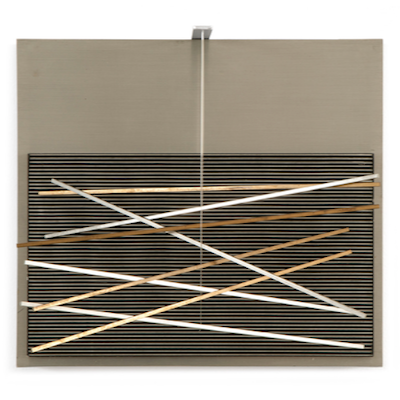


Details
Artist
Styles
Printed on a creamy paper - Published by Börjeson, Malmö, Sweden // Victor Vasarely's Terz Liten (1978) is a screen print that exemplifies the artist's pioneering role in the Op Art movement. This limited edition print, with an edition size of 200, plays with geometric precision to create an optical illusion of a three-dimensional sphere emerging from a flat, grid-like surface. The repeated triangular and square patterns in red, black, and white converge towards the center, generating a sense of depth and movement. The piece draws viewers into a mesmerizing visual experience, with the pattern seemingly pulsating and shifting as the eye moves across the composition. Published by Börjeson in Malmö, Sweden, Terz Liten is printed on creamy paper, enhancing its refined, high-contrast aesthetic.
Terz Liten, 1978
form
Medium
Size
30 x 24 cm
- Inches
- Centimeters
Edition
Price
- USD
- EUR
- GBP
Details
Artist
Styles
Printed on a creamy paper - Published by Börjeson, Malmö, Sweden // Victor Vasarely's Terz Liten (1978) is a screen print that exemplifies the artist's pioneering role in the Op Art movement. This limited edition print, with an edition size of 200, plays with geometric precision to create an optical illusion of a three-dimensional sphere emerging from a flat, grid-like surface. The repeated triangular and square patterns in red, black, and white converge towards the center, generating a sense of depth and movement. The piece draws viewers into a mesmerizing visual experience, with the pattern seemingly pulsating and shifting as the eye moves across the composition. Published by Börjeson in Malmö, Sweden, Terz Liten is printed on creamy paper, enhancing its refined, high-contrast aesthetic.
- Recently Added
- Price (low-high )
- Price (high-low )
- Year (low-high )
- Year (high-low )
What is kinetic art?
Kinetic art is an international movement that emerged in the 1920s and gained prominence in the 1960s, referring to art that involves both apparent and real motion. It encompasses any medium that includes movement, either relying on actual motion for its effect or being perceived as moving by the viewer. Early examples include canvas paintings designed to create optical illusions of movement. Today, kinetic art often refers to three-dimensional figures and sculptures, such as those operated by machines or those that move naturally. The movement covers a variety of styles and techniques that frequently overlap.









































































